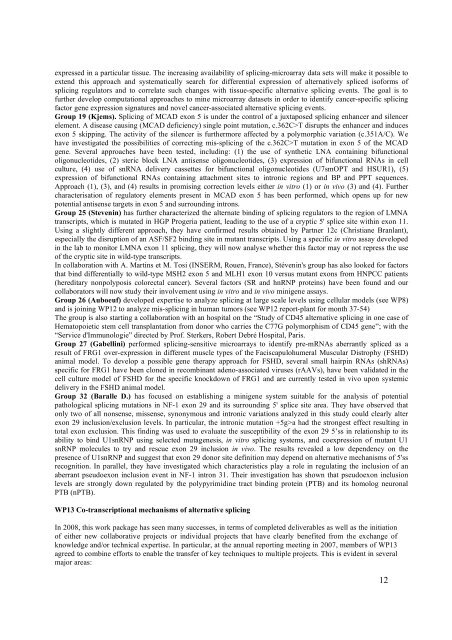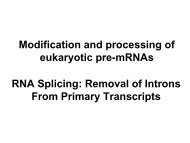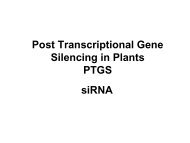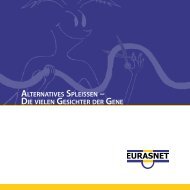Create successful ePaper yourself
Turn your PDF publications into a flip-book with our unique Google optimized e-Paper software.
expressed in a particular tissue. The increasing availability of splicing-microarray data sets will make it possible toextend this approach and systematically search for differential expression of alternatively spliced isoforms ofsplicing regulators and to correlate such changes with tissue-specific alternative splicing events. The goal is tofurther develop computational approaches to mine microarray datasets in order to identify cancer-specific splicingfactor gene expression signatures and novel cancer-associated alternative splicing events.Group 19 (Kjems). Splicing of MCAD exon 5 is under the control of a juxtaposed splicing enhancer and silencerelement. A disease causing (MCAD deficiency) single point mutation, c.362C>T disrupts the enhancer and inducesexon 5 skipping. The activity of the silencer is furthermore affected by a polymorphic variation (c.351A/C). Wehave investigated the possibilities of correcting mis-splicing of the c.362C>T mutation in exon 5 of the MCADgene. Several approaches have been tested, including: (1) the use of synthetic LNA containing bifunctionaloligonucleotides, (2) steric block LNA antisense oligonucleotides, (3) expression of bifunctional RNAs in cellculture, (4) use of snRNA delivery cassettes for bifunctional oligonucleotides (U7smOPT and HSUR1), (5)expression of bifunctional RNAs containing attachment sites to intronic regions and BP and PPT sequences.Approach (1), (3), and (4) results in promising correction levels either in vitro (1) or in vivo (3) and (4). Furthercharacterisation of regulatory elements present in MCAD exon 5 has been performed, which opens up for newpotential antisense targets in exon 5 and surrounding introns.Group 25 (Stevenin) has further characterized the alternate binding of splicing regulators to the region of LMNAtranscripts, which is mutated in HGP Progeria patient, leading to the use of a cryptic 5' splice site within exon 11.Using a slightly different approach, they have confirmed results obtained by Partner 12c (Christiane Branlant),especially the disruption of an ASF/SF2 binding site in mutant transcripts. Using a specific in vitro assay developedin the lab to monitor LMNA exon 11 splicing, they will now analyse whether this factor may or not repress the useof the cryptic site in wild-type transcripts.In collaboration with A. Martins et M. Tosi (INSERM, Rouen, France), Stévenin's group has also looked for factorsthat bind differentially to wild-type MSH2 exon 5 and MLH1 exon 10 versus mutant exons from HNPCC patients(hereditary nonpolyposis colorectal cancer). Several factors (SR and hnRNP proteins) have been found and ourcollaborators will now study their involvement using in vitro and in vivo minigene assays.Group 26 (Auboeuf) developed expertise to analyze splicing at large scale levels using cellular models (see WP8)and is joining WP12 to analyze mis-splicing in human tumors (see WP12 report-plant for month 37-54)The group is also starting a collaboration with an hospital on the “Study of CD45 alternative splicing in one case ofHematopoietic stem cell transplantation from donor who carries the C77G polymorphism of CD45 gene”; with the“Service d'Immunologie” directed by Prof. Sterkers, Robert Debré Hospital, Paris.Group 27 (Gabellini) performed splicing-sensitive microarrays to identify pre-mRNAs aberrantly spliced as aresult of FRG1 over-expression in different muscle types of the Faciscapulohumeral Muscular Distrophy (FSHD)animal model. To develop a possible gene therapy approach for FSHD, several small hairpin RNAs (shRNAs)specific for FRG1 have been cloned in recombinant adeno-associated viruses (rAAVs), have been validated in thecell culture model of FSHD for the specific knockdown of FRG1 and are currently tested in vivo upon systemicdelivery in the FSHD animal model.Group 32 (Baralle D.) has focused on establishing a minigene system suitable for the analysis of potentialpathological splicing mutations in NF-1 exon 29 and its surrounding 5' splice site area. They have observed thatonly two of all nonsense, missense, synonymous and intronic variations analyzed in this study could clearly alterexon 29 inclusion/exclusion levels. In particular, the intronic mutation +5g>a had the strongest effect resulting intotal exon exclusion. This finding was used to evaluate the susceptibility of the exon 29 5’ss in relationship to itsability to bind U1snRNP using selected mutagenesis, in vitro splicing systems, and coexpression of mutant U1snRNP molecules to try and rescue exon 29 inclusion in vivo. The results revealed a low dependency on thepresence of U1snRNP and suggest that exon 29 donor site definition may depend on alternative mechanisms of 5'ssrecognition. In parallel, they have investigated which characteristics play a role in regulating the inclusion of anaberrant pseudoexon inclusion event in NF-1 intron 31. Their investigation has shown that pseudoexon inclusionlevels are strongly down regulated by the polypyrimidine tract binding protein (PTB) and its homolog neuronalPTB (nPTB).WP13 Co-transcriptional mechanisms of alternative splicingIn <strong>2008</strong>, this work package has seen many successes, in terms of completed deliverables as well as the initiationof either new collaborative projects or individual projects that have clearly benefited from the exchange ofknowledge and/or technical expertise. In particular, at the annual reporting meeting in 2007, members of WP13agreed to combine efforts to enable the transfer of key techniques to multiple projects. This is evident in severalmajor areas:12







